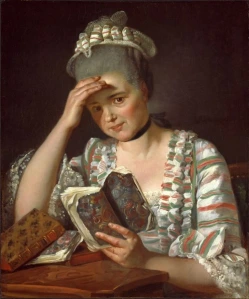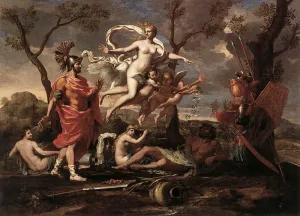The art and scientific discovery period of classical art was full of discovery and change. The scientific art started in the 1700s. The extremely unique thing that came with this is also woman appearing in these paintings when woman were not shown along side science.
Madame Francis Buron
Painted by Jacques Louis David
painted in 1769
This painting is an oil painting. A fun fact is this painting is
Davids' aunt. This painting almost has a whimsical feeling but with a beautiful softness. Light contrast is strongly used in this painting to emphasize his aunt. This painting is important because it shows this woman reading and gives a vibe and feel of her being an educated female. Her clothing gives a sense of comfort and higher society. You can tell by the strong detail and gentle look that this painting was done with a love and relationship between the painter and the subject.
Painted by: Joseph Wright of Derby
1763-65
This painting is also part of the scientific age of art. You can visibly see the studying going on in this painting. It is also an oil painting. You can sense the awe and wonder in the young children's faces. The gentle men are deep in thought and studying. Light is strongly used here to make the object being studied stand out. The people in the painting are more in the background as a secondary view but still draw your attention to them. This painting is strong in emphasizing the science being studied at this time era. Just like the previous painting there is also a female painted in. She is more shadowed and doesn't stand out anywhere to the extent that the men do but it is still a female brought into the view of science.
Venus Presenting Arms to Aeneas
1639
This painting by Poussin brings in a whole different aspect of the arts and science. This brings in more of the music part of science and discovery. The big thing that draws my attention is the
mythical with the human aspect that is also being drawn in. You see the cupids along side the figure of Venus. You can also see multiple kind of people. You have the soldiers as well as the men and women laying bare and raw around them. This painting brings a feeling of something important. It feels like a sense of strength being given when looking at it. you also get a feeling of comfort and relaxation with the soft curving and calm poses of the people in the background. If feel like the brightness of Venus really brings her to the forefront but then you have the red of the robes bringing your view next to the soldiers. The soldier gives a sense that he is protecting the people around him.
All these paintings are related by the time era of Classical art they belong to. At the same time they are drastically different in what they portray. I personally feel I would own these and have to hang them with an individual light on each to make them stand out even more. I feel these are all such strong paintings that they belong in a museum. These are strong examples of the Classical Era.
Works Cited
David, Jacques Louis. “Madame François Buron.” The Art Institute of Chicago, Painting and Sculpture of Europe, 1 Jan. 1769, www.artic.edu/artworks/88632/madame-francois-buron.
Venus Presenting Arms to Aeneas by Poussin, Nicolas, www.wga.hu/html_m/p/poussin/2a/22venus.html. Accessed 23 Oct. 2023.
“Venus Presenting Arms to Aeneas.” Musée Des Beaux-Arts, 18 June 2013, mbarouen.fr/en/oeuvres/venus-presenting-arms-to-aeneas.
“Wright of Derby, a Philosopher Lecturing on the Orrery (Article).” Khan Academy, Khan Academy, www.khanacademy.org/humanities/ap-art-history/later-europe-and-americas/enlightenment-revolution/a/wright-of-derby-a-philosopher-lecturing-on-the-orrery. Accessed 23 Oct. 2023.




I like how you picked the art and scientific discovery period of classical art! I was going to do my project on that but decided to do it on something else. The painting that you picked gives a very educational purpose vibe. I learned that in the Classical Era, science was seen as going against religion
ReplyDelete